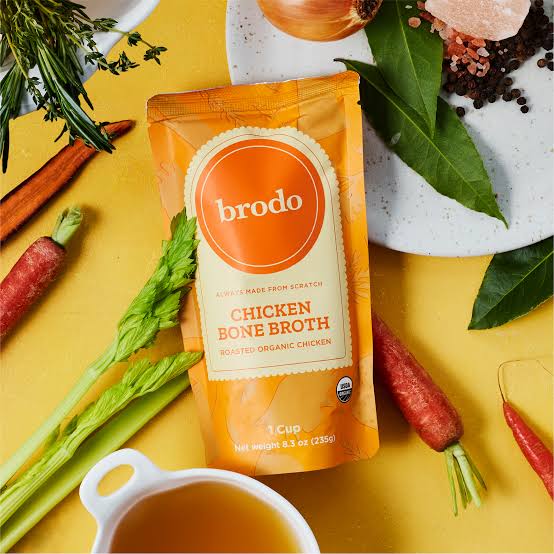Bone broth is a nutritious and flavorful liquid made by simmering animal bones, often with vegetables, herbs, and spices, for an extended period of time. This slow-cooked broth extracts nutrients like collagen, gelatin, amino acids, and minerals from the bones, making it a popular health tonic. It’s been a staple in many traditional diets for centuries but has recently gained popularity due to its potential health benefits.
Here’s everything you need to know about bone broth:
Table of Contents:
- What is Bone Broth?
- Health Benefits of Bone Broth
- How to Make Bone Broth
- Bone Broth vs. Stock vs. Broth
- How to Incorporate Bone Broth into Your Diet
- Wrapping Up: Is Bone Broth Worth the Hype?
- Frequently Asked Questions
1. What is Bone Broth?
Bone broth is made by simmering animal bones (such as beef, chicken, or fish) with water, vegetables like carrots and onions, herbs like thyme and bay leaves, and sometimes a small amount of vinegar. The vinegar helps break down the collagen in the bones, turning it into gelatin, which gives bone broth its signature rich and silky texture. The simmering process can take anywhere from 12 to 48 hours, allowing nutrients to be fully extracted from the bones.
2. Health Benefits of Bone Broth
Bone broth has become known for its potential to support overall health. While more research is needed to fully confirm some of these claims, many people swear by the benefits it offers:
- Supports Joint Health: Bone broth is rich in collagen, which breaks down into gelatin and provides amino acids like proline and glycine that support joint health and mobility.
- Boosts Immune System: The amino acids found in bone broth may help support a healthy immune system. Bone broth can also be soothing when you’re sick, helping to hydrate and comfort you.
- Improves Gut Health: The gelatin in bone broth can help protect and heal the lining of the digestive tract, supporting gut health and digestion.
- Supports Skin Health: Collagen is essential for healthy skin, and consuming bone broth regularly can promote skin elasticity and reduce wrinkles.
- Rich in Minerals: Bone broth is packed with essential minerals, including calcium, magnesium, potassium, and phosphorus, which are important for bone health, muscle function, and hydration.
3. How to Make Bone Broth
Making bone broth at home is quite simple, though it requires time and patience. Here’s a basic recipe:
Ingredients:
- 2-3 pounds of bones (chicken, beef, or pork)
- 1 onion, quartered
- 2 carrots, chopped
- 2 celery stalks, chopped
- 2 cloves of garlic, smashed
- 2 tablespoons apple cider vinegar (helps extract minerals)
- Water (enough to cover the bones)
- Salt and pepper to taste
- Optional: Herbs like thyme, bay leaves, or parsley
Instructions:
- Roast the Bones (optional but adds flavor): If you’re using beef or pork bones, roast them in the oven at 400°F for about 30 minutes to enhance their flavor.
- Combine Ingredients: In a large pot or slow cooker, add the bones, vegetables, garlic, vinegar, and herbs. Pour in enough water to fully cover everything.
- Simmer: Bring the pot to a boil, then reduce the heat to low and let it simmer for 12 to 48 hours. The longer you cook it, the richer and more flavorful the broth will be. If using a slow cooker, set it to low and let it cook for up to 48 hours.
- Skim and Strain: Throughout the cooking process, you may need to skim off impurities that rise to the surface. Once done, strain the broth to remove the bones and vegetables.
- Cool and Store: Let the broth cool to room temperature, then store it in the fridge for up to 5 days or freeze it for long-term storage.
4. BoneBroth vs. Stock vs. Broth
Although the terms “bonebroth,” “stock,” and “broth” are often used interchangeably, there are subtle differences:
- BoneBroth: Made by simmering bones (often with some meat still attached), and cooked for an extended period (12-48 hours), resulting in a rich, gelatinous texture.
- Stock: Also made by simmering bones, but typically cooked for a shorter period (usually 4-6 hours). Stock tends to be thicker than broth due to the collagen content but is not as rich as bonebroth.
- Broth: Usually made by simmering meat (with or without bones) for a few hours. It’s lighter and more liquidy than stock or bonebroth.
5. How to Incorporate BoneBroth into Your Diet
Bonebroth is incredibly versatile and can be used in a variety of ways:
- As a drink: You can drink bonebroth on its own, either hot or cold, as a health tonic.
- In soups and stews: Use bonebroth as the base for your favorite soups, stews, or chili.
- In cooking grains: Cook rice, quinoa, or other grains in bonebroth to add flavor and nutrients.
- In sauces and gravies: Use bonebroth as the liquid for making rich sauces, gravies, or reductions.
- In smoothies: Some people even add a scoop of collagen powder or a splash of bonebroth to their smoothies for an extra protein boost.
Final Ideas
Bone broth is certainly gaining popularity, and for good reason. It’s nutritious, versatile, and packed with potential health benefits. Whether you’re drinking it for your joints, skin, or gut health, or simply enjoying it as a comforting, flavorful liquid, bonebroth can easily fit into a healthy diet. If you have the time, making it at home can be a rewarding experience. But if you’re short on time, there are plenty of high-quality store-bought options available too.
People Also Ask
Q1: Can I make bonebroth in a pressure cooker?
Yes, you can! Using a pressure cooker like an Instant Pot can significantly reduce cooking time, usually allowing you to make bonebroth in 2-3 hours instead of 12-48 hours.
Q2: How often should I drink bonebroth?
There’s no set rule, but many people aim to drink a cup of bone broth daily or several times a week to reap its health benefits.
Q3: Can I add bonebroth to my diet if I’m vegetarian or vegan?
While bonebroth is made from animal bones, plant-based versions called “vegetable broths” can be made using similar principles (simmering vegetables for an extended period). These won’t provide the same collagen benefits but still offer nutrients and flavor.
Q4: Can I freeze bonebroth?
Yes! Bonebroth freezes well and can be stored in airtight containers for up to 6 months. You can also freeze it in ice cube trays for easy portioning.
Conclusion
Bone broth is more than just a comfort food; it’s a nutrient-packed liquid that can offer numerous health benefits. Whether you make it at home or buy it pre-made, adding bone broth to your diet is an easy and delicious way to boost your health, support your joints, and improve your skin. Plus, it’s versatile enough to be used in a variety of dishes, making it a staple in many kitchens!



